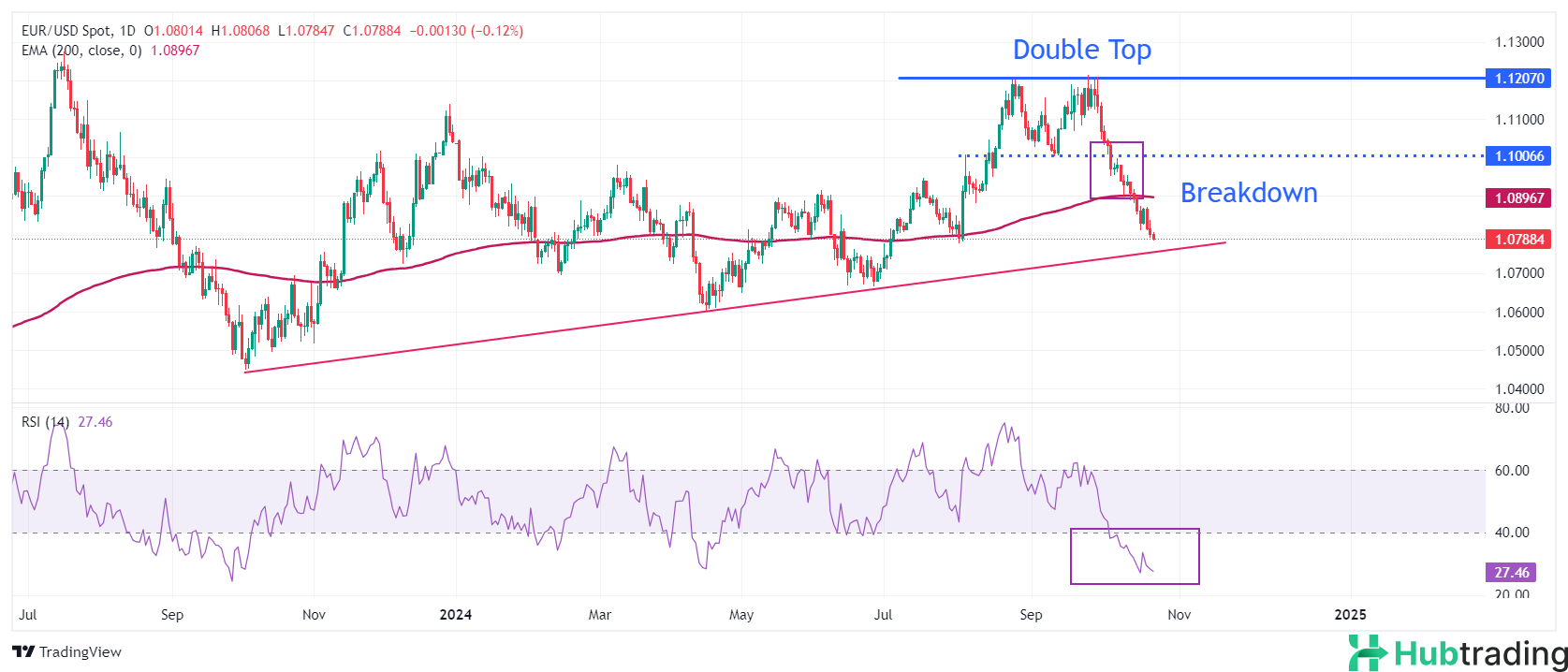- EUR/USD declines further as several ECB policymakers indicate they expect the Deposit Facility Rate to drop below the neutral level of around 2% to 2.25%.
- ECB President Lagarde expressed optimism about inflation declining faster than anticipated.
- Uncertainty surrounding the upcoming US presidential election is likely to keep market sentiment fluctuating.
EUR/USD remains under pressure as the outlook for the Euro (EUR) has deteriorated due to a faster-than-expected decline in inflation and increasing risks of an economic downturn in the Eurozone. These factors have sparked speculation about further interest rate cuts by the European Central Bank (ECB).
Having already lowered its Deposit Facility Rate three times this year, the ECB is widely expected to cut rates again at its December meeting. As a result, traders are beginning to speculate on where ECB borrowing rates might settle—an optimal level that could both control inflation and stimulate growth.
Recent discussions among ECB officials have focused on whether interest rates could drop below the so-called neutral rate to bolster economic growth and mitigate inflation risks, according to Reuters. Lithuanian central bank governor and ECB Governing Council member Gediminas Šimkus recently highlighted the risk of inflation staying too low, suggesting that if disinflation becomes entrenched, rates might fall below the neutral level, which is estimated to be around 2% to 2.25%.
On Tuesday, ECB President Christine Lagarde expressed confidence in inflation sustainably returning to the bank's 2% target by 2025, earlier than previously anticipated. In an interview with Bloomberg at the International Monetary Fund (IMF) meeting, she stated that while the direction of monetary policy is clear, the pace of future interest rate cuts will depend on incoming economic data.
Daily Digest: Market Movers – EUR/USD Weakens Amid US Election Jitters
- EUR/USD has slid to around 1.0780 in Wednesday's European session, facing selling pressure as the US Dollar (USD) rallies. The US Dollar Index (DXY), which measures the Greenback against six major currencies, has extended its gains to 104.20, eyeing the August high of 104.45. This strength in the Dollar is largely attributed to political uncertainty ahead of the US presidential election and firm expectations that the Federal Reserve's (Fed) policy-easing cycle will be more gradual than previously anticipated.
- Market sentiment has shifted, with increasing speculation that former President Donald Trump could secure a victory in the upcoming election. However, the latest Reuters/Ipsos polls indicate that current Vice President Kamala Harris holds a slight lead. A Trump win is expected to lead to higher tariffs and lower taxes, potentially prompting the Fed to adopt a more restrictive policy stance.
- Meanwhile, the market anticipates that the Fed will cut interest rates by a total of 50 basis points (bps) by the end of the year, with two 25 bps cuts likely in November and December, according to the CME FedWatch tool.
- Analysts suggest that the Fed is unlikely to implement another significant rate cut like the one seen in September, especially given that recent Nonfarm Payrolls (NFP) data indicate sustained labor demand. UBS analysts noted, "Wage growth has slowed since the peak in 2022, but it remains stronger than at any point in the decade before the pandemic."
- Investors will closely monitor the Fed's Beige Book, scheduled for release at 18:00 GMT, along with remarks from several Fed and ECB officials, including President Lagarde.
Technical Analysis: EUR/USD Trends Toward 1.0750

EUR/USD is testing levels below 1.0800 during European trading hours, maintaining a downbeat outlook as it remains below the 200-day Exponential Moving Average (EMA) around 1.0900.
The decline followed a breakdown of a Double Top formation on the daily chart near the September 11 low around 1.1000, signaling a bearish reversal.
The 14-day Relative Strength Index (RSI) has dipped below 30.00, indicating strong bearish momentum, although a recovery could be possible as conditions appear oversold.
On the downside, support for the pair could be found near the upward-sloping trendline at 1.0750, drawn from the October 3 low around 1.0450. Resistance levels to watch include the 200-day EMA and the psychological level at 1.1000.





